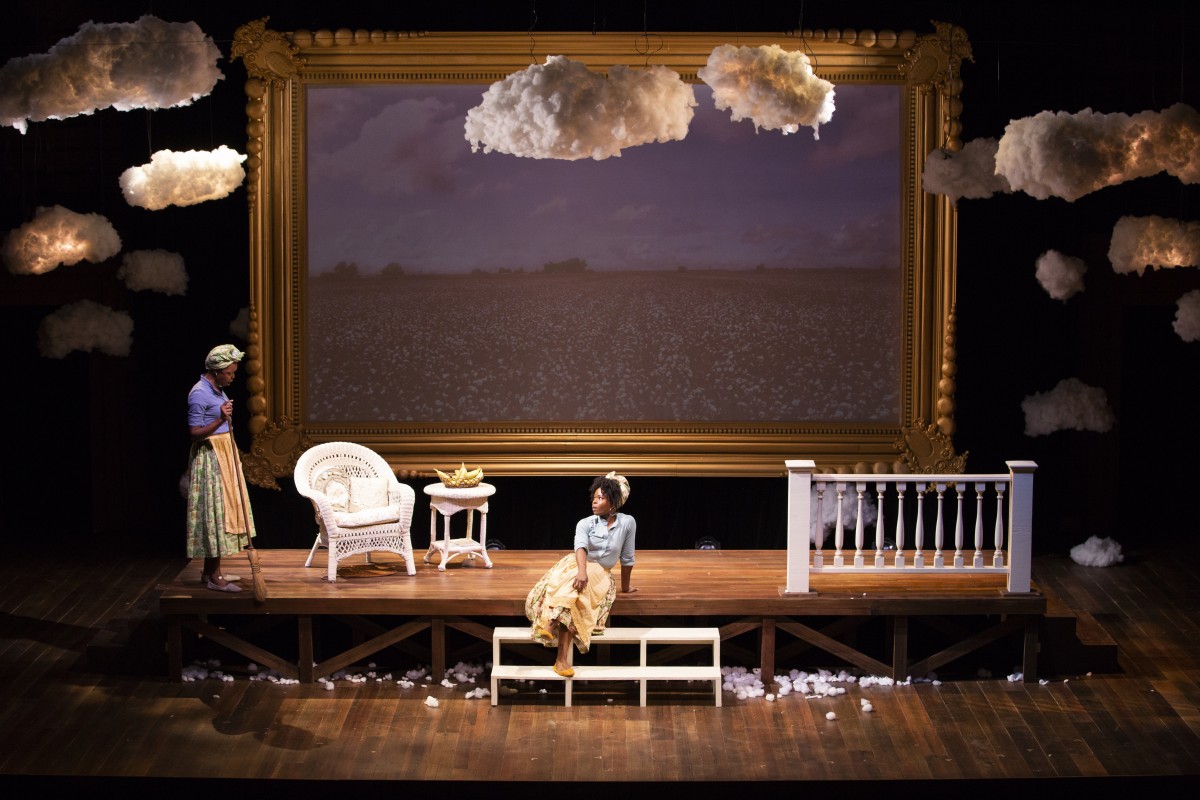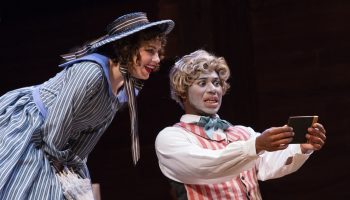Through an ironic use of bright lights and colorful costumes, Chautauqua Theater Company’s production of An Octoroon poses some big questions about America’s history with slavery.
CTC Artistic Associate Sarah Wansley said An Octoroon’s melodramatic in influences were paramount.
“The play only works if the style is leaned into visually,” Wansley said. “When you’re creating a melodrama, it’s not just about the actors having a heightened sense of truth and big physical gestures. You also need bright colors. You also need underscoring.”
An Octoroon continues its run with a performance at 2:15 p.m. Wednesday, July 4, in Bratton Theater. Although comedic in nature, the play is not recommended for children due to strong language and content.
The word melodrama comes from the Greek word “melos,” for music. The form came out of opera and originated in Pygmalion, a 1770 play that combined monologues with musical interludes.
Because contemporary theater does not rely as much on underscoring, sound designer Vincent Olivieri said that he turned to classic films.
“We’re using a lot of the score from ‘Gone With the Wind’ as underscoring moments … to really enhance the ideas and to separate the mid-19th century language from contemporary language,” he said. “That being said, there is a modern frame to this as well, so the first music you hear is not going to be Golden Age of Hollywood.”
For the show’s prologue, Olivieri sampled Beyoncé and Childish Gambino, two artists who comment on race in America through their art, much like Branden Jacobs-Jenkins, the playwright of An Octoroon.
As the first bars from “Gone With the Wind” crackle over Bratton’s speakers, actors pull back a vaudeville-inspired curtain to reveal a cotton-covered set designed by Lee Savage. A giant, gilded picture frame at the back of the stage hosts projected backdrops that establish the Terrebonne plantation.
“We definitely wanted the space to feel like a contemporary play, but within that there are sort of quotations and inspirational elements drawn from the 19th century,” Savage said.
Cotton clouds loom above from fishing line or aircraft cables, depending on their size. Inside them are lanterns, sometimes taped together, that light up the sky according to lighting designer Alan C. Edwards’ vision.
While Edwards said his lighting design is not overtly melodramatic, he used foot lights on the rim of the stage to supplement An Octoroon’s vaudeville aesthetic.
Costume designer Sarah Nietfeld said that she began by researching period-appropriate clothing before brainstorming how the costumes could combine realism with melodrama.
For the character Dora, a white heiress played by conservatory actor Jenny Latimer, Nietfeld said she wanted the character’s pompous dresses to look doll-like, yet believable.
“She’s really comedic, but she’s also trapped by the gender roles of her time,” Nietfeld said. “Her skirts and Zoe’s skirts are slightly too short just to push it, because everything in this play is pushed.”
Nietfeld said Savage’s set design research inspired her to print small images of plantations on the enslaved women’s scarves and aprons.
“These plantations are really horrible … but these pictures are so pastel and pretty and inviting looking,” she said. “Finding those prints was really helpful in creating that melodramatic plantation world that Branden Jacobs-Jenkins is showing us with his text.”
Nietfeld also tracked down images from the 1912 silent film adaptation of The Octoroon, Dion Boucicault’s 1859 play that served as the basis for Jacobs-Jenkins’ An Octoroon. Although she was disappointed that she could not find a copy of the film, Nietfeld said the still images inspired the hat, coat and mustache of the dastardly M’Closky.
Because it was illegal at the time for people of color to perform on stage, Boucicault himself played the Native American character Wahnotee, a fact that is critiqued in Jacobs-Jenkins’ play. With this in mind, Nietfeld disregarded accuracy when assembling guest artist Brett Rickaby’s costume.
“We found really fake items that aren’t authentic and are not specific to any one tribe because that’s what Boucicault was doing, and that is what Branden is using to make a point,” Nietfeld said.
Several of the play’s stock characters are played by the same actor, which required Nietfeld to use snaps and elastic to accommodate their frequent quick changes backstage.
“It was about finding a balance between what iconic things show these very different characters, but what also could be simplified so that this could be totally streamlined,” Nietfeld said.
In one scene, guest actor Larry Powell plays the noble George and evil M’Closky at the same time, which required a creative solution from the costume department.
“What we did was cut two (frock coats) straight down the middle and frankensteined them together,” Ni- etfeld said. “That was really fun to figure out.”
Savage said that while the design is rooted in melodrama, An Octoroon is still very much a contemporary play.
“We wanted to embrace the theatricality of the piece and the style of melodrama without really realizing it,” he said, “in the same way the play does that.”







